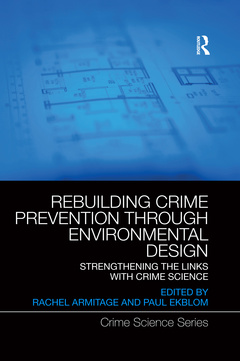Rebuilding Crime Prevention Through Environmental Design Strengthening the Links with Crime Science Crime Science Series
Coordonnateurs : Armitage Rachel, Ekblom Paul

Crime Prevention Through Environmental Design (CPTED) is a practice-oriented approach to reduce the risk of offences such as burglary and fear of crime by modifying the built environment. In recent years, this approach has been criticised for duplicating terminology and for failing to integrate successfully with other approaches.
Rebuilding Crime Prevention Through Environmental Design explores and extends the common ground between CPTED and situational crime prevention ? another traditional approach in the field of crime prevention and security ? via the latter?s evolution into the field of crime science. Drawing on international research to develop new interdisciplinary perspectives, this volume explores how situational crime prevention and environmental criminological theories relate to those of Crime Prevention Through Environmental Design and considers how crime science can be reformulated to merge different approaches, or at least articulate them better.
Rebuilding Crime Prevention Through Environmental Design will appeal to students, applied academic researchers and practitioners who wish to deepen their understanding and contribute in turn to the ongoing revitalisation of the field.
1. Introduction
Paul Ekblom and Rachel Armitage
2. Moving home as a flight from crime: residential mobility as a cause and consequence of crime and a challenge to Crime Prevention Through Environmental Design
Michelle Rogerson and Ken Pease OBE
3. "Why my house?" – exploring the influence of residential housing design on burglar decision making
Rachel Armitage and Chris Joyce
4. Using guardianship and Situational Crime Prevention (SCP) to strengthen Crime Prevention Through Environmental Design (CPTED)
Danielle M. Reynald and Mateja Mihinjac
5. Sharpening up CPTED – towards an ontology based on crime science and ecology
Paul Ekblom
6. Simulating CPTED: computational agent-based models of crime and environmental design
Daniel Birks and Joseph Clare
7. Simulation of dependencies between armed response vehicles and CPTED measures in counter-terrorism resource allocation
Hervé Borrion, Octavian Ciprian Bordeanu and Sonia Toubaline
8. Crime Prevention Through Environmental Design (CPTED) in Malaysia: development of a tool to measure CPTED implementation in residential settings
Massoomeh Hedayati Marzbali, Aldrin Abdullah and Mohammad Javad MaghsoodiTilaki
9. How to ruin CPTED
Ward A. Adams, Eric S. McCord and Marcus Felson
10. A decade developing the delivery of CPTED across Greater Manchester
Leanne Monchuk
11. Less crime, more vibrancy, by design
Marcus Willcocks, Paul Ekblom and Adam Thorpe
12. Conclusion
Rachel Armitage and Paul Ekblom
Rachel Armitage is Professor of Criminology within the School of Human and Health Sciences at the University of Huddersfield, UK.
Paul Ekblom is Emeritus Professor of Design Against Crime at Central Saint Martins, University of the Arts London, UK; and Visiting Professor at both UCL and the University of Huddersfield, UK.
Date de parution : 09-2020
15.6x23.4 cm
Date de parution : 02-2019
15.6x23.4 cm
Thème de Rebuilding Crime Prevention Through Environmental Design :
Mots-clés :
CPTED Principle; CPTED Measurement; Environmental Criminology; CPTED Concept; Situational Crime Prevention; Crime Pattern Theory; Computational Criminology; CPTED Practitioner; Community Safety; CPTED Strategy; Crime Controllers; CPTED Feature; CPTED Approach; Crime Science; Defensible Space; Crime Prevention; Rios Insua; Armed Response Vehicles; Crime Research Centre; High Resident Turnover; High Residential Turnover; Routine Activity Approach; NDC Area; Natural Surveillance; Abandoned Properties; Validation Checklist; West Louisville



